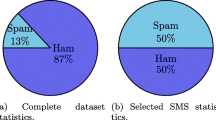Abstract
In recent years, with technical improvements and growth in content-based advertising, individuals have started utilizing SMS (Short Message Service), which has resulted in a significant increase in spam SMS. African continent experiences the most spam SMS in the globe, with an average of 119 spam SMS received per month by a person. These spam SMS are unsolicited messages to users, which are disturbing and may sometimes lead to the loss of important data. There exist many spam SMS detection methods which are impacted by the inclusion of well-known words, phrases, abbreviations, and idioms. The proposed work is using supervised machine learning techniques such as Multinomial Naïve Bayes and Support Vector Machine to identify SMS as spam or ham and compare their results based on specific evaluation parameters to find the most effective technique for filtering messages. The technique is evaluated on a real-world SMS dataset including over 5572 messages. According to the findings, the Support Vector Machine algorithm is the best at classifying SMS as spam or ham with an accuracy of 98.83%.
Access this chapter
Tax calculation will be finalised at checkout
Purchases are for personal use only
Similar content being viewed by others
References
S.M. Abdulhamid et al., A review on mobile SMS spam filtering techniques. IEEE Access 5, 15650–15666 (2017). https://doi.org/10.1109/ACCESS.2017.2666785
https://www.slicktext.com/blog/2018/11/44-mind-blowing-sms-marketing-and-texting-statistics/
S. Agarwal, S. Kaur, S. Garhwal, SMS spam detection for Indian messages, in 2015 1st International Conference on Next Generation Computing Technologies (NGCT) (2015), pp. 634–638. https://doi.org/10.1109/NGCT.2015.7375198
D. Delvia Arifin, Shaufiah, M.A. Bijaksana, Enhancing spam detection on mobile phone Short Message Service (SMS) performance using FP-growth and Naïve Bayes classifier, in 2016 IEEE Asia Pacific Conference on Wireless and Mobile (APWiMob) (2016), pp. 80–84. https://doi.org/10.1109/APWiMob.2016.7811442
M. Gupta, A. Bakliwal, S. Agarwal, P. Mehndiratta, A comparative study of spam SMS detection using machine learning classifiers, in 2018 Eleventh International Conference on Contemporary Computing (IC3) (2018), pp. 1–7. https://doi.org/10.1109/IC3.2018.8530469
P. Navaney, G. Dubey, A. Rana, SMS spam filtering using supervised machine learning algorithms, in 2018 8th International Conference on Cloud Computing, Data Science & Engineering (Confluence) (2018), pp. 43–48. https://doi.org/10.1109/CONFLUENCE.2018.8442564
Alzahrani, D.B. Rawat, Comparative study of machine learning algorithms for SMS spam detection, in 2019 SoutheastCon (2019), pp. 1–6. https://doi.org/10.1109/SoutheastCon42311.2019.9020530
J. Gomez Hidalgo, G. Bringas, E. Sanz, F. García, Content based SMS spam filtering, in Proceedings of the 2006 ACM Symposium on Document Engineering (2006), pp. 107–114. https://doi.org/10.1145/1166160.1166191
M. Popovac, M. Karanovic, S. Sladojevic, M. Arsenovic, A. Anderla, Convolutional neural network based SMS spam detection, in 2018 26th Telecommunications Forum (TELFOR) (2018), pp. 1–4. https://doi.org/10.1109/TELFOR.2018.8611916
Author information
Authors and Affiliations
Corresponding author
Editor information
Editors and Affiliations
Rights and permissions
Copyright information
© 2023 The Author(s), under exclusive license to Springer Nature Singapore Pte Ltd.
About this paper
Cite this paper
Patil, L., Sakhidas, J., Jain, D., Darji, S., Borhade, K. (2023). A Comparative Study of Spam SMS Detection Techniques for English Content Using Supervised Machine Learning Algorithms. In: Thampi, S.M., Mukhopadhyay, J., Paprzycki, M., Li, KC. (eds) International Symposium on Intelligent Informatics. ISI 2022. Smart Innovation, Systems and Technologies, vol 333. Springer, Singapore. https://doi.org/10.1007/978-981-19-8094-7_16
Download citation
DOI: https://doi.org/10.1007/978-981-19-8094-7_16
Published:
Publisher Name: Springer, Singapore
Print ISBN: 978-981-19-8093-0
Online ISBN: 978-981-19-8094-7
eBook Packages: EngineeringEngineering (R0)




